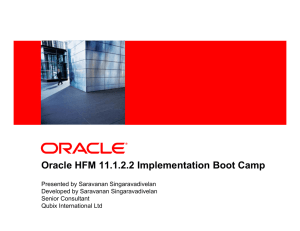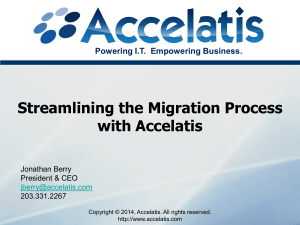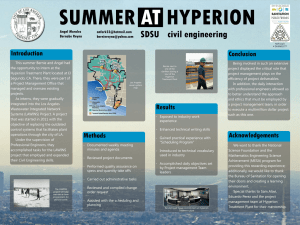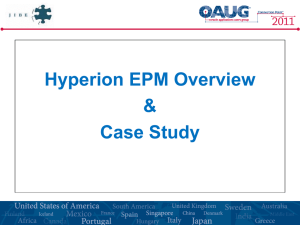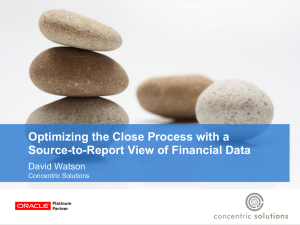Integrated Business Plan
advertisement
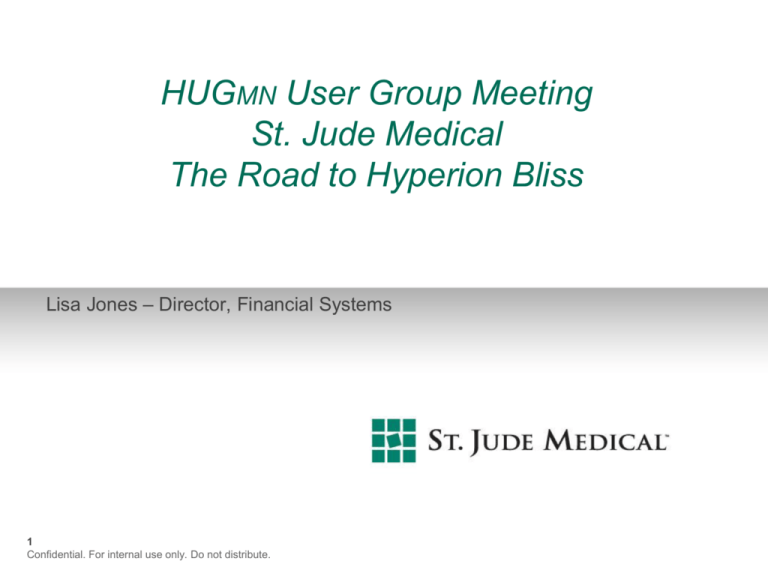
HUGMN User Group Meeting St. Jude Medical The Road to Hyperion Bliss Lisa Jones – Director, Financial Systems 1 Confidential. For internal use only. Do not distribute. Agenda Hyperion Road Map Hyperion Planning Implementation Overview of Planning/Forecasting Process Redesign of Hyperion Planning Big Wins Lessons Learned DRM Hyperion Planning Upgrade HFM Implementation FDM Batch Automation Application Support 2 Confidential. For internal use only. Do not distribute. Hyperion Road Map JAN 2004 MAR 2011 JUN 2012 JUN 2013 JAN 2014 JUN 2014 • Hyperion Enterprise • Hyperion Planning Implementation • Hyperion Planning Re-design • Hyperion Planning Upgrade to 11.1.2.2 • HFM Implementation • Project ReOrg 3 Confidential. For internal use only. Do not distribute. STJ Forecast/Plan Cycles – No changes were made to our Planning process as a result of the Hyperion Planning Implementation Cycle ** February is the only month that does not have an active cycle** Start End Cycle Length (system open to final submission) Forecast (4 Quarterly Forecasts) Forecast1.1 12/19/13 01/12/14 24 days Forecast2.1 03/01/14 04/11/14 41 days Forecast3.1 05/31/14 07/11/14 41 days Forecast4.1 07/27/14 10/10/14 75 days Outlook1.1 02/27/14 03/14/14 16 days Outlook2.1 05/29/14 06/13/14 15 days Outlook3.1 08/27/14 09/12/14 16 days Outlook4.1 11/26/14 12/12/14 16 days 07/27/14 11/14/14 110 days 02/27/14 07/13/14 137 days Outlook (4 Quarterly Outlooks) AOP (Annual Operating Plan) 4 Confidential. For internal use only. Do not distribute. 4 STRAT (5 year Strategic Plan) Hyperion Planning – Initial Design Hyperion Plan Types (CVPLAN) REVSCOGS OPEXPROJ WRKFORCE Input of Units, Revenue, Scogs & Ocogs Input of Operating expenses by cost center, by project Detailed employee information (US employees only, workforce planning has not been rolled out for OUS employees). Essbase Cubes (All BSO Cube) FX2RVOP CNFX3 FX Engine used for loading of actual data in transactional input and converting to USD. End users do not have access this cube. Currency Neutralized data. The majority of our management reporting is out of this Essbase cube CMFX3 • Currency Modeling. Used only by Corporate FP&A to model planning data at various FX rate assumptions. DRM EPMA Planning Essbase Cubes 5 Confidential. For internal use only. Do not distribute. Hyperion Planning – Initial Design Reports Revscogs Input/Calc/ Agg Acct Period Geo Entity Year Scenario Version CNFX3 Calc/Agg Opexproj Input/Calc/ Agg Project Wrkforce Input/Calc/ Agg Project Employee 6 Confidential. For internal use only. Do not distribute. Acct Period Geo Entity Year Scenario Version CMFX3 Calc/Agg Acct Period Geo Entity Year Scenario Version Issues with original design Hourly TransAgg Within CVPLN, after a planner input data they would have to Biggest complaint wait until the Hourly from end users TransAgg ran at the top of the hour before they could see the consolidated numbers. Aggregations WF cube has so many members, the Agg All took longer than 8 hours to finish. The Revcogs and OpExpProj cube took under an hour to finish. Currency Neutralized Data A full currency neutral push was only run once a night to convert Total SJM at all FX rates (Fcst rates, Plan rates, PY rates). Therefore, CVPLN and CNFX3 were only in sync once per day. 7 Confidential. For internal use only. Do not distribute. Enterprise Was still considered book of record. Most reporting was still coming out of Enterprise. Made for twice the amount of work ensuring that HP tied to Enterprise. Double effort to support both systems with same level of detail Security Groups After our initial Go-Live there was an immediate need for each division to be able to lock out their end users but still let the Divisional FP&A users have “write” access Workforce Employee Sort Employee Dimension was sourced with position ID, not last name. This made it very hard for a cost center planner who had 25+ employees in a cost center because the employees did not show up alphabetically. Object Inventory out of Control We have 3 distinct planning cycles (AOP/FCST/O L), that overlap. System was initially designed for to allow for only one cycle open at a time. Redesign - “Rocket the data” 1. 2. 3. 4. Faster Aggregation Input/Calc and translate in BSO (CVPLN) Move zero level data to ASO Aggregate in ASO Result: Moves the aggregation function to the ASO database BSO Input/ Calc/ Translate 8 8 8 Confidential. For internal use only. Do not distribute. ASO Aggregate Hyperion Planning Re-design Highlights BSO aggregations take hours, ASO aggregations take minutes Eliminate CNFX3/CMFX3. Offer one ASO cube for all management reporting Eliminate the Hourly TransAgg Eliminate manual CNFX3 pushes Eliminate the need for a division to run aggregation business rules Created Security groups by function by division Increased data storage options Reduce the number of business rules in Calc Manager Use “scripts” that can be used in multiple business rules to reduce the number of objects Each web form contains a “string of pearls” that translates the data in CVPLN and then pushes the data to the ASO cube to be aggregated Close to real time aggregations. No more waiting for hourly TransAgg and CNFX3 pushes. Most web forms run in less than 30 seconds. Took a process that took hours and reduced it to seconds. When a user hits save on a web form and receives the message that the business rule ran successfully. The data is fully translated/aggregated No more waiting!!! 9 Confidential. For internal use only. Do not distribute. Happy End Users and Acceptance of new tool Hyperion Planning – Big Wins 1. Currency Modeling – Previously we did not load plan/forecast data in local currency therefore it was very difficult to run accurate currency modeling. Now that all countries input in local dollars, we have a very accurate way to model planning data at different FX rate assumptions. 2. Currency Neutralization – All countries submit in local dollars, we are able to run currency neutral at all rates. This used to be maintained offline in Excel spreadsheets 3. One Global Planning System – We have one Planning system that is supported centrally by the EFS. This gives us transparency into the numbers since everyone is using the same system, provides more discipline in the planning process and serves as “one version of the truth”. 4. 15 Month AOP cycle – Beginning with FY12 Forecast4.1/FY13 AOP we implemented a 15 month rolling forecast. This allowed users ability to stay within one form instead of switching between cycles. 10 Confidential. For internal use only. Do not distribute. Hyperion Planning – Lessons Learned Lessons Learned 1. STJ Involvement – The majority of the project was designed and led by External Consultants. The EFS team was not established until November 2010. We should have had full-time dedicated STJ resources on the project from day 1. 2. Data Reconciliation - The effort of data reconciliation was significantly underestimated and we ultimately went live with no historical data. 3. Phased Implementation – We should have gone with a phased implementation (by division or by plan type) rather than implementing all divisions, all plan types at one time. 4. Delay Workforce – We should have looked at phasing in the workforce cube after all users were comfortable with the new Planning system. Workforce is definitely the most complicated cube type and initially EFS spent majority of production support on workforce related issues. 5. Financial Reports – too much time was spent on developing F/R reports that were never used. As time has gone by, we have started to create more reports, but in the beginning, 100% of the reporting was coming out of Spreadsheet Add-in or SmartView. 6. Consistency of Metadata – It is important to set standards and naming conventions at the start of the project so that your application is clean and consistent across all the dimensions. 7. Detailed Documentation within Calc Scripts– The best place to document what a Calc script is doing is within the calc script itself. If all of your Calc Scripts have good documentation it will allow for easier knowledge transfer between external consultants and internal resources. 8. Use of Global Forms – Important to get agreement with all divisions on web form design so you can use “global” forms that apply to all divisions rather than creating customized divisional web forms as it is more 11 objects toFor maintain/update a go-forward basis. Confidential. internal use only. Do on not distribute. DRM – Data Relationship Manager Nightly SAP feeds for new CC/PC • DRM EPMA • EPMA deploys all the Essbase Cubes Excel Automator templates from Divisions EFS Team Maintains all metadata 12 Confidential. For internal use only. Do not distribute. Division FP&A users rely heavily on DRM to view hierarchies Why did we upgrade to 11.1.2.2 We struggled with EPMA in the 11.1.1.3 version GIT was heavily pushing physical to virtual servers Erroneous Data Issue in 11.1.1.3 that was fixed in version 11.1.2.2 SmartView enhancements with the new version of 11.1.2.2 Organization Announcement drove many changes to web forms/metadata HFM and Planning need to be on the same version because they closely aligned and share workspace and/or metadata 13 Confidential. For internal use only. Do not distribute. HP HFM Essbase FDM DRM EPMA Version 11.1.2.2 What was included in the Upgrade Environments The Infrastructure was converted from an all physical environment to virtual environment Combined OLK/FCST Combined Outlook/Forecast forms into one set of forms Combined Divisions Web forms for CVD/AFD and NMD/CRMD into IESD/CATD. This also included Metadata updates for the new combined product divisions. ID Regional Reporting Updated ID Geography to accommodate new Regional Structure 14 Confidential. For internal use only. Do not distribute. Revenue Planning Levels Condensed the revenue planning levels for CATD. Scogs Logic Changes 4 different methods for calculating extended standard dollars Std Cost is planned by LA/OUS/US WForce Seeding Rebuilt the workforce seeding process (Swap Employee ID for Position ID) RDS Utilizing RDS to access SmartView Lessons Learned of Upgrade System Performance • We did not do enough performance /stress testing Virtual Environment • Hyper-threading should be turned off for virtual Essbase. • Read/Write SSDI Hitachi Disk 15 Confidential. For internal use only. Do not distribute. Multiple Changes • We incorporated too many changes/enhanc ements along with the Upgrade • Made it more difficult to isolate what was culprit of all the system crashes Level of Effort • Underplayed the size of this transition, and could really think of it as a complete new go-live project as opposed to just an upgrade. Hyperion Enterprise Overview Hyperion Enterprise: 1. Historically used for way more than a consolidation tool 2. Very detailed account structure 3. Contains Actuals, Plan, Forecast data @ various CN rates 4. Very Stable system for 9+ years FDM 1. FDM used for loading actuals. 2. 75+ locations in FDM. All Co Code owners were responsible for loading/reconciling data against source G/L 3. Inconsistent Mappings 16 Confidential. For internal use only. Do not distribute. Reporting 1. Used for external/legal entity reporting. 2. Considered official book of record for actuals Data Sources 1. Plan/Forecast data was fed from Hyperion Planning back into Enterprise 2. Reconciliation of actual data was tied out between Hyperion Planning and Enterprise HFM Implementation Goals/Objectives Apply Lessons Learned from HP & Upgrade Ensure that project was on time, on budget with no critical issues. Avoid recreating Enterprise Stepped back during requirements gathering to ensure we designed HFM to meet external reporting needs and not re-create Enterprise. Centralize Mappings We wanted to implement more control to gain consistent and more accurate mapping of actuals Project Team Smaller project team, longer burn rate. SME’s from STJ involved from day one of the project HFM / HP Don’t duplicate data in multiple systems. Use HFM for what it was intended for. 17 Confidential. For internal use only. Do not distribute. Key Design Elements of HFM HFM will be used for External/Legal Entity Reporting HFM will not contain any management reporting HFM will only contain actual data @ actual rates HFM will not contain detailed cost center or profit center information FDM will be automated by Batch & centralized within EFS HFM will produce a cash flow by Legal Entity HFM will contain supplemental web forms to replace offline data collection 2 years of historical data will be converted 18 Confidential. For internal use only. Do not distribute. Current Hyperion Environments 19 Confidential. For internal use only. Do not distribute. HFM Project Team External Team • 2 to 3 HFM experts • 1 to 2 FDM/Batch Automations • 1 F/R Report Writer • 1 Training Manual Writer 2 full time dedicated STJ employees 2 part time STJ employee 2 full time STJ PM’s Magic of the Project Room • Externals • • • • 20 Confidential. For internal use only. Do not distribute. Project Team sat together from Day one. Knowledge Transfer between externals & employees occurred on a daily basis Impromptu Design / White board discussions early on and throughout project No surprises Team camaraderie STJ FDM Batch Automation FDM is centrally maintained by EFS Batch Automation occurs every 4 hours during close week FDM feeds both Essbase & HFM. All database are updated at the top of the hour within minutes of each other Co Code owners are still responsible for tying out their P&L and B/S from HFM to source systems EFS Team is responsible for tying data out between HFM and Essbase on a legal entity basis Huge Success • Initially thought users would dislike loosing control of their own maps • Batch is controlled by CPS. 21 Confidential. For internal use only. Do not distribute. Suspense Members/Error Handling Shortened the Close Process • Within FDM, we have suspense members for any mapping kickouts. • EFS team receives emails if any errors occur during batch automation • Even though taking a day out of the process was not a goal of this requirements, we were able to shorten our cycle to a 4 day close largely due to Batch Automation HFM Successes Measure of Success Project was on time, under budget with no defects heading into Go-live We actually closed January quicker than we had in Enterprise for the first month under HFM Data reconciliation was led by SME’s We had 2 years of historical data in HFM within 2 months of having our dimensions built. By July of 2013 we were pretty much a week behind the official Hyperion Enterprise Close Requirement Sign-off were held in person with all divisions meeting to walk through requirements We had very little change requests or scope creep Training was delivered by EFS Team User acceptance of HFM was very high and they picked up the new tool very quickly. Unit Testing, UAT and Parallel Closes were very successful We completed 3 rounds of parallel testing and were able to close out all defects prior to Go-live Knowledge Transfer occurred during project We were able to roll off the external consultants within 1 week of closing the books for January. EFS team was ready to support the application 22 Confidential. For internal use only. Do not distribute. HFM Successes (cont’d) Measure of Success Out of box I/C Matching Reduced many manual hours spent on reconciling I/C matching reports HFM Supplemental Web Forms Huge gain in efficiencies by our SEC and Tax Department by leveraging HFM web forms. They now spend time analyzing the data instead of ticking & tying the data. Duplicate Data No longer spend time reconciling detailed data between all the systems. Accuracy of data mappings The reconciliation between source G/L (primary SAP) and HFM is almost automatic Financial Reporting We only created minimum amount of F/R reports in HFM. Users still tend to like Excel based reports. Cash Flow by Legal Entity Utilize the HFM supplemental web forms to roll forward assets, Liab and equity and cash flow has been 85% automated 23 Confidential. For internal use only. Do not distribute. HFM – BIG WIN All projects should be modeled after this one 10 Months after HFM Go-live We wouldn’t change one design decision 24 Confidential. For internal use only. Do not distribute. EFS Support Model Global Support Finance Org • The EFS team is located around the world to ensure we can support a global application. We rely heavily on 2 OUS EFS team members to support Europe, AsiaPac and Japan • The EFS team rolls up to the Vice President of Corporate FP&A Finance Org. Most of the EFS team has an accounting/finance background and tended to gravitate to the financial system side • We primarily have one person in charge of all the infrastructure/environments Infrastructure BA’s Time • The team is comprised of very senior level Business Analysts with lots of STJ knowledge and strong financial system skills • EFS spends about 50% time on production support type issues and about 40% on enhancements and 10% on misc. tasks 25 Confidential. For internal use only. Do not distribute. Project ReOrg HFM was NOT Impacted!!! Multiple WebForm Changes Announced in January 2014 Standardized Workforce Calculations Major Changes to all Objects in Planning/Essbase Cubes. Brand New Security Groups EFS Team was able to handle all changes while maintaining production support In Production By July 2014 Change FDM Maps 26 Confidential. For internal use only. Do not distribute. 3 years of Data Restatements Cutover was Smooth & System was stable User Counts Hyperion Planning ~800 users HFM ~200 users DRM ~75 users Enterprise Financial Systems Team SmartView Essbase Add-in ~500 users EPMA ~2 users FDM ~10 users 27 Confidential. For internal use only. Do not distribute. Our Journey over the past 4 years Challenging Exciting Exhausting Rewarding Frustrating EverChanging 28 Confidential. For internal use only. Do not distribute. STABLE
